5 affordable instruments perfect for beginners
5 affordable instruments perfect for beginners — a quick, practical guide to the best starter instruments, why I picked them, and how to choose one that gets you playing fast. I compare cost, ease, and learning speed, then share simple tips for kids, adults, accessories, and a smart shopping checklist so you can start with confidence.
Key takeaway
- Start with the ukulele for fast chord wins.
- Choose an acoustic guitar to practice strumming and singer‑songwriter songs.
- Use a starter keyboard to learn notes, chords, and harmony.
- Try a recorder (or harmonica) to build breath control and melody.
- Pick a cajon (or simple percussion) to train steady rhythm.
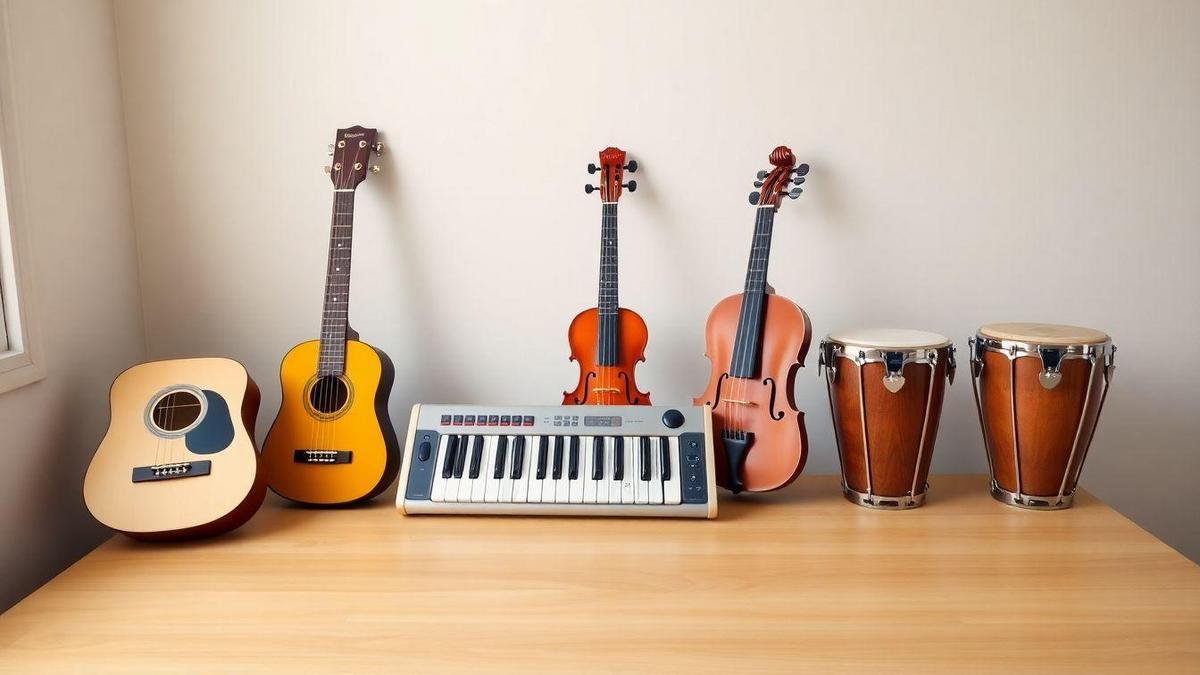
If you’re unsure which direction to take, my practical comparison of styles and long‑term fit can help you decide: how to match instruments to your musical goals.
Quick overview: 5 affordable instruments perfect for beginners
This guide focuses on five instruments that offer fast wins, low entry cost, good playability, and plenty of learning resources. Use the short ratings and tips to match the instrument to your goals. For an external perspective on choosing, see how to choose your first instrument.
How I compare each instrument
I score instruments by three measures: Cost (typical starting price), Ease (1 = easiest), and Learning Speed (how fast you can play simple songs).
| Instrument | Typical price (USD) | Ease (1=easy) | Learning speed | Best for |
|---|---|---|---|---|
| Ukulele | $30–$120 | 1 | Fast (weeks) | Pop, folk, sing‑along |
| Acoustic guitar | $100–$300 | 2 | Moderate (months) | Folk, rock, singer‑songwriter |
| Keyboard (61‑key) | $80–$200 | 2 | Moderate (months) | Pop, electronic, piano basics |
| Recorder | $10–$30 | 1 | Fast (weeks) | School music, classical intro |
| Harmonica | $15–$50 | 1 | Fast (weeks) | Blues, folk, jams |
If you want instant satisfaction pick ukulele, recorder, or harmonica. For broader musical options later, pick guitar or keyboard.
Why I picked these 5 affordable instruments perfect for beginners
- Cheap to start and easy to carry.
- Quick progress keeps practice consistent.
- Work across many styles: pop, folk, classical, and blues.
- Good used options are widely available.
Real-life note: my first ukulele let me learn three songs in two weeks — that small win kept me practicing.
If you need step‑by‑step shopping confidence, my checklist and buying tactics are summarized in how to choose your first instrument without regrets.
Practice tip
Short daily sessions beat one long session. I practice 15 minutes a day and improve faster than with weekend marathons. For structured routines and goal setting, see a simple daily practice routine and the evidence behind focused practice in the power of just twenty minutes daily.
What I check when choosing a starter instrument
Always check five things: Price, Playability, Sound, Durability, and Learning resources.
| Criterion | What I check |
|---|---|
| Price | Usable quality under ~$150 when possible |
| Playability | Neck width, action, key travel, comfort |
| Sound | Clear tone at low volume for home practice |
| Durability | Solid hardware, no fragile parts |
| Learning resources | Apps, lessons, tabs, or books available |
Practical checks: for guitar, test action and frets. For keyboard, press every key. For ukulele, check tuning pegs and fret edges. For recorder and harmonica, test tone and reed response.
How I choose the best acoustic guitar for beginners
Focus on comfort, playability, and sound. Avoid high action and heavy bodies. Try sizes and strings in person.
Body sizes and who they suit
| Body size | Best for | What to listen for |
|---|---|---|
| Parlor / Concert | Small hands, travel | Comfortable reach, softer bass |
| Grand Concert / Auditorium | Most beginners | Balanced tone, easy hold |
| Dreadnought | Players wanting more volume | Strong bass, bigger feel |
Prefer light‑gauge steel strings for adults and nylon for kids or classical learners. When buying used under $100, prioritize setup condition (neck straightness, frets, bridge) over brand. For an authoritative overview, consult this beginner acoustic guitar buying guide.
If you’re choosing between guitar, keyboard, or drums for your style and space, my in‑depth comparisons can help finalize which instrument suits your life: guitar vs keyboard vs drums: pick the right fit.
My top affordable guitar features: straight neck, low‑to‑medium action, light gauge strings, solid tuners, and no major cracks.
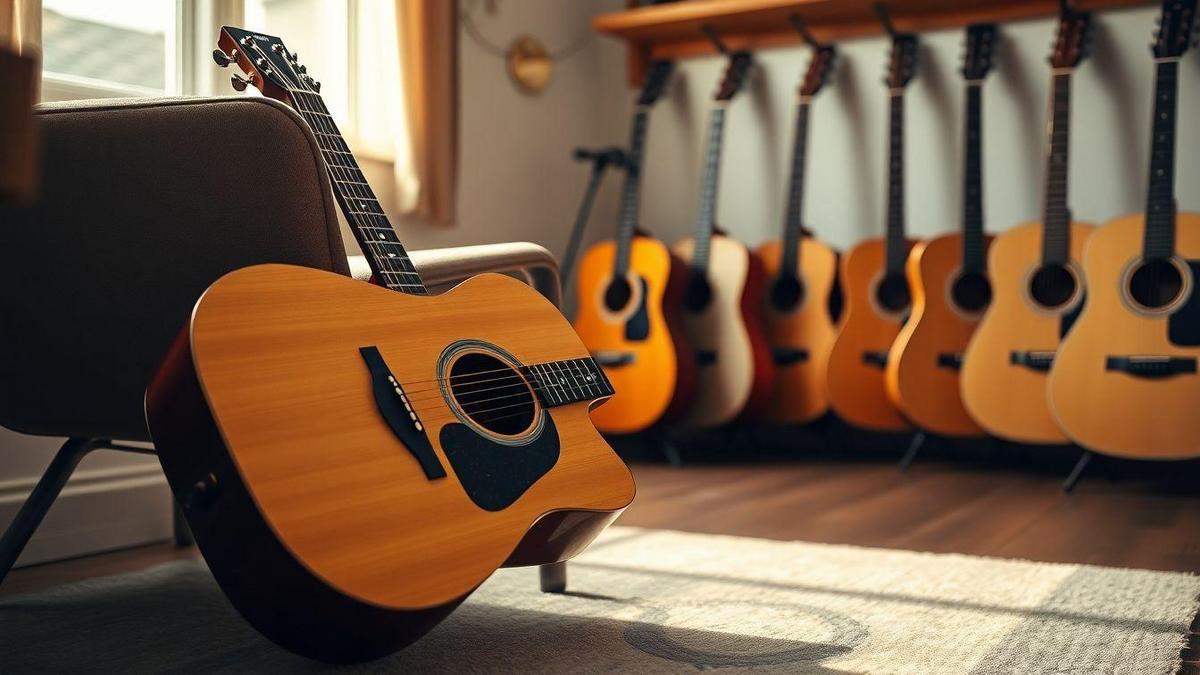
How I pick the best ukulele for beginners
Choose size by hand fit and goals: soprano (small, classic tone), concert (balanced, most starters), tenor (fuller tone, fingerstyle). Comfort first, tone second.
| Size | Scale | Typical frets | Sound | Good for |
|---|---|---|---|---|
| Soprano | ~13″ | 12–15 | Bright | Small hands |
| Concert | ~15″ | 15–17 | Balanced | Most beginners |
| Tenor | ~17″ | 17–19 | Fuller | Bigger hands, fingerstyle |
Budget guide: under $60 may be toy‑like; $60–$150 is a decent starter; $150–$300 is solid beginner quality. When shopping used, test tuning and action. I keep a short comparison list titled “5 affordable instruments perfect for beginners” to speed decisions.
Ukulele buying checklist
- Size that fits your hands
- Low action, no buzzing
- Tuners that hold pitch
- Straight neck and smooth frets
- New or good strings (replace if needed)
- No cracks; good tone when strummed
- Soft gig bag or case is a plus
- Return policy (≥14 days)
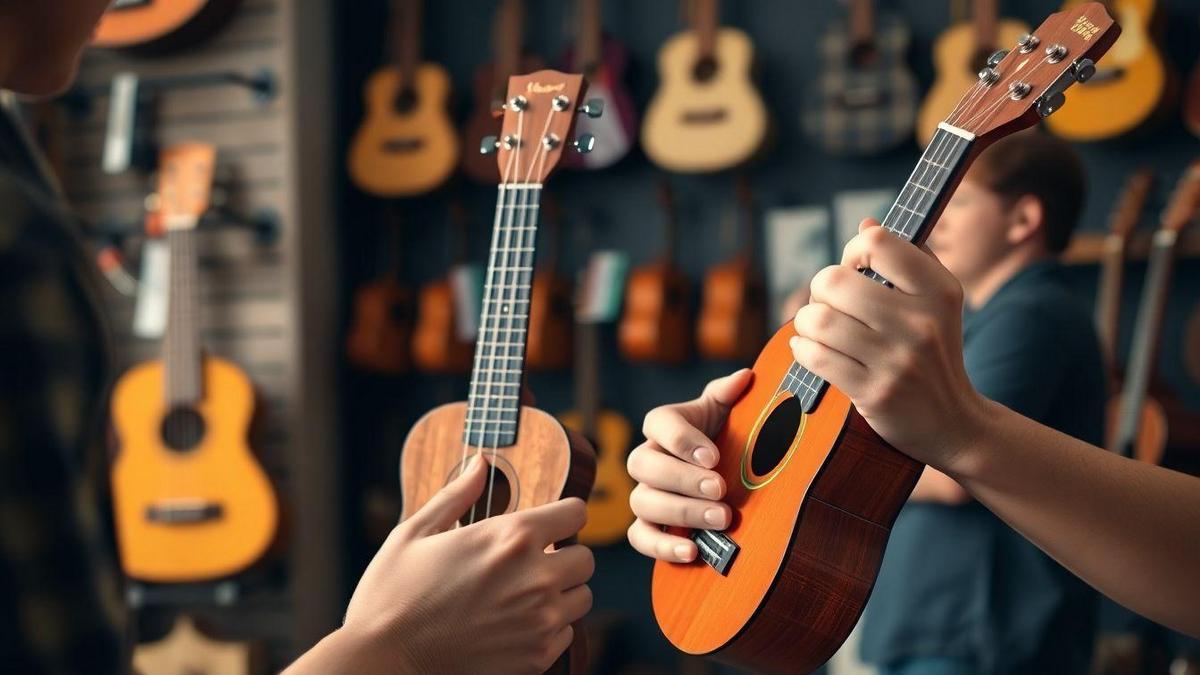
Why I recommend a starter keyboard for beginners
A starter keyboard gives fast feedback on notes, chords, and rhythm. It’s portable and helps build finger strength and basic music reading. For the list of 5 affordable instruments perfect for beginners, the keyboard often ranks high because of its visual layout and versatility. For practical advice on selecting a starter keyboard, see starter keyboard selection and recommendations.
Key count and touch sensitivity
- Aim for at least 49 keys (49–61 is ideal for serious beginners).
- Prefer touch sensitivity so you learn dynamics.
- 61 keys covers most beginner repertoire; 88 keys for long‑term pianists.
My picks under $100 focus on essentials: headphone jack, built‑in speakers, battery adapter power, and basic presets/metronome.
If you’re torn between guitar and keyboard for songwriting or arrangement, see the comparison that highlights how each supports composing: guitar vs keyboard for songwriters.
Keyboard practice setup
- Keyboard on a stable stand
- Bench at correct height
- Headphones for quiet practice
- Metronome (app or device)
- Notebook with short goals: 5 min scales, 10 min songs
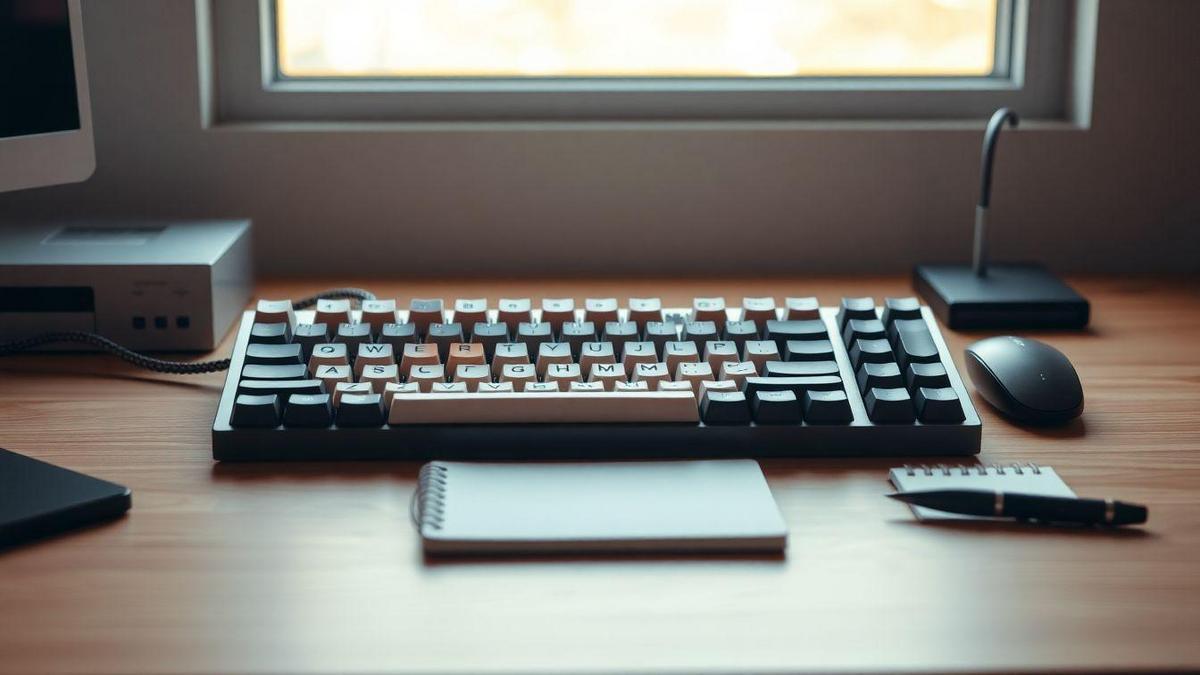
How I approach a cheap beginner violin for learners
Measure arm length (extend left arm, measure neck base to middle fingertip) to pick size; test fit and posture. Check strings, bridge, pegs, and fingerboard before buying.
| Arm length | Violin size |
|---|---|
| under 19″ | 1/8 |
| 19″–21″ | 1/4 |
| 21″–23″ | 1/2 |
| 23″–25″ | 3/4 |
| 25″ | 4/4 (full) |
Test tone by playing open strings and scales. If a cheap violin feels right and makes you smile when you bow, it will keep a beginner practicing — and that positive feeling is often the most important part of starting, addressed in overcoming the fear of starting music.
Basic maintenance
- Wipe body & strings after each session
- Rosin lightly on bow hair weekly
- Tune before every lesson
- Loosen bow hair after use
- Luthier setup once after purchase
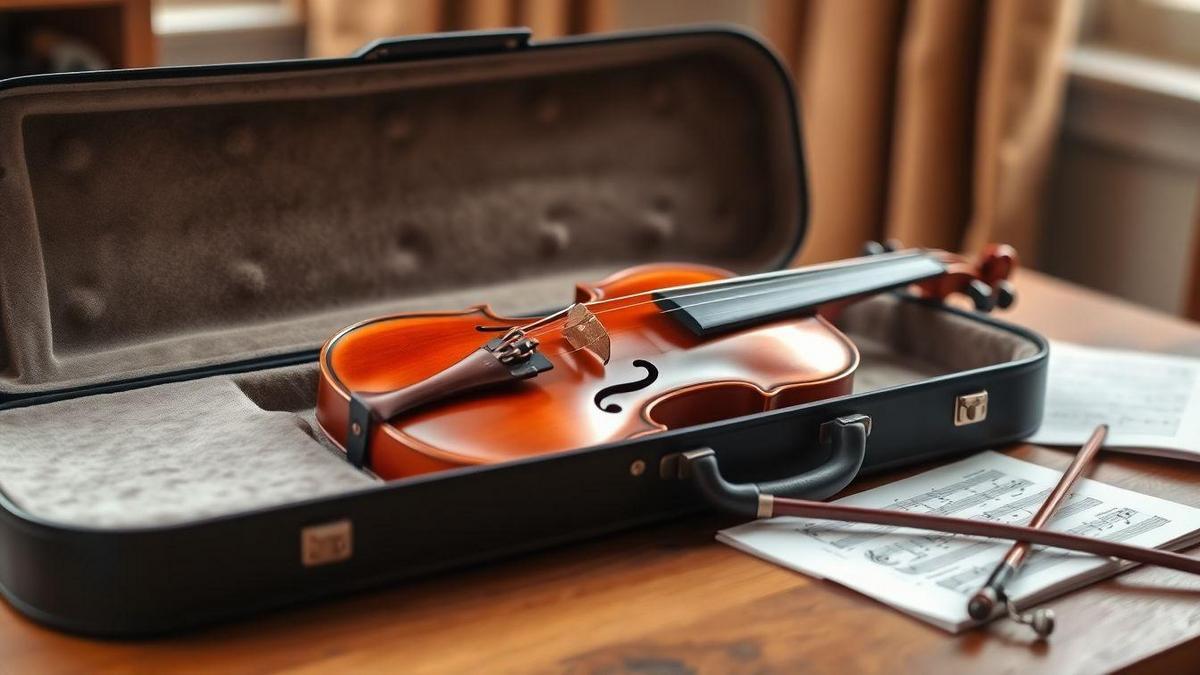
How I evaluate affordable beginner wind instruments
I test for tone within five minutes, check size/weight, mouthpiece comfort, and cleaning needs. For easy wind starts consider recorder, harmonica, and tin whistle. If you plan to start harmonica, check this harmonica basics and beginner advice.
- Recorder: Very cheap, little maintenance, clear finger patterns.
- Harmonica: Portable, great for blues/folk; check reed response.
- Tin whistle: Bright, good for melody and ornamentation.
Reed and cleaning checklist: identify reed type, check replacement cost, inspect mouthpiece for gaps/sharp edges, test moisture handling, and prefer instruments with cleaning kits available.
Top wind picks (part of the 5 affordable instruments perfect for beginners)
| Instrument | Why I like it | Price range | Maintenance |
|---|---|---|---|
| Recorder | Fast results, cheap | $5–$30 | Low: rinse & dry |
| Harmonica | Portable, versatile | $10–$40 | Moderate: dry after use |
| Tin whistle | Clear tone, small hands | $10–$35 | Low: wipe & dry |
| Ocarina | Sweet tone, simple holes | $15–$50 | Low |
| Melodica | Keyboard breath | $25–$70 | Moderate: clean mouthpiece & reeds |
I learned to buy one step up in quality after bending a cheap harmonica reed in month one.
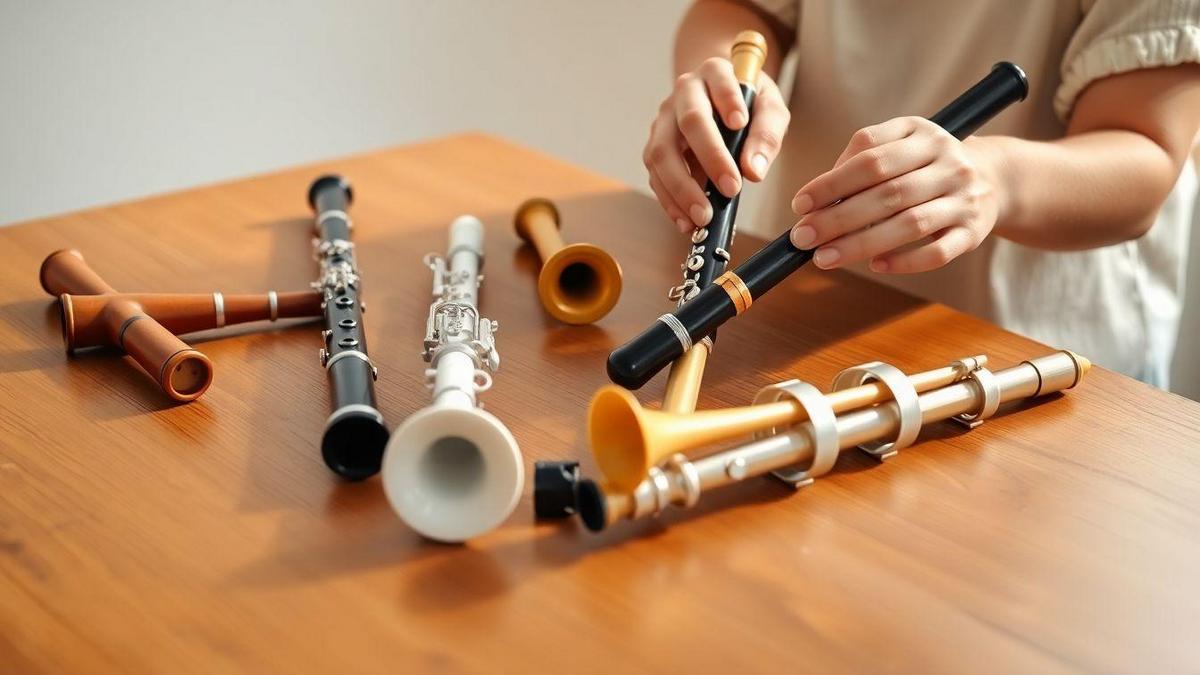
Helping parents choose budget‑friendly starter instruments for kids
Measure reach and strength, prefer durable materials (laminate, hard plastics), check safety (rounded edges, non‑toxic finishes), and match instrument size to play time. National guidelines and tips for families are available at advice for parents choosing instruments.
| Instrument | Best ages | Durability | Price |
|---|---|---|---|
| Recorder | 5–8 | High (plastic) | $10–$40 |
| Ukulele | 5–10 | Good (laminate) | $30–$120 |
| Keyboard (61) | 6 | High | $70–$250 |
| Violin (1/4) | 4–8 | Moderate (wood) | $80–$250 |
| Acoustic guitar (3/4) | 6 | Moderate | $80–$300 |
If commitment is uncertain, rent. Rentals lower upfront cost and often include maintenance. If a child keeps lessons for several months, buying usually becomes cheaper.
Tips: try before you buy, set a firm budget, prioritize playability (low action, smooth keys), get a return trial or warranty, and include essentials (case, tuner, strap).
To understand whether your child needs prodigy‑level talent or steady practice, see talent vs practice: can anyone learn music.
I recommend these 5 affordable instruments perfect for beginners for kids: recorder, ukulele, keyboard (61‑key), violin (student size), and acoustic guitar (3/4).
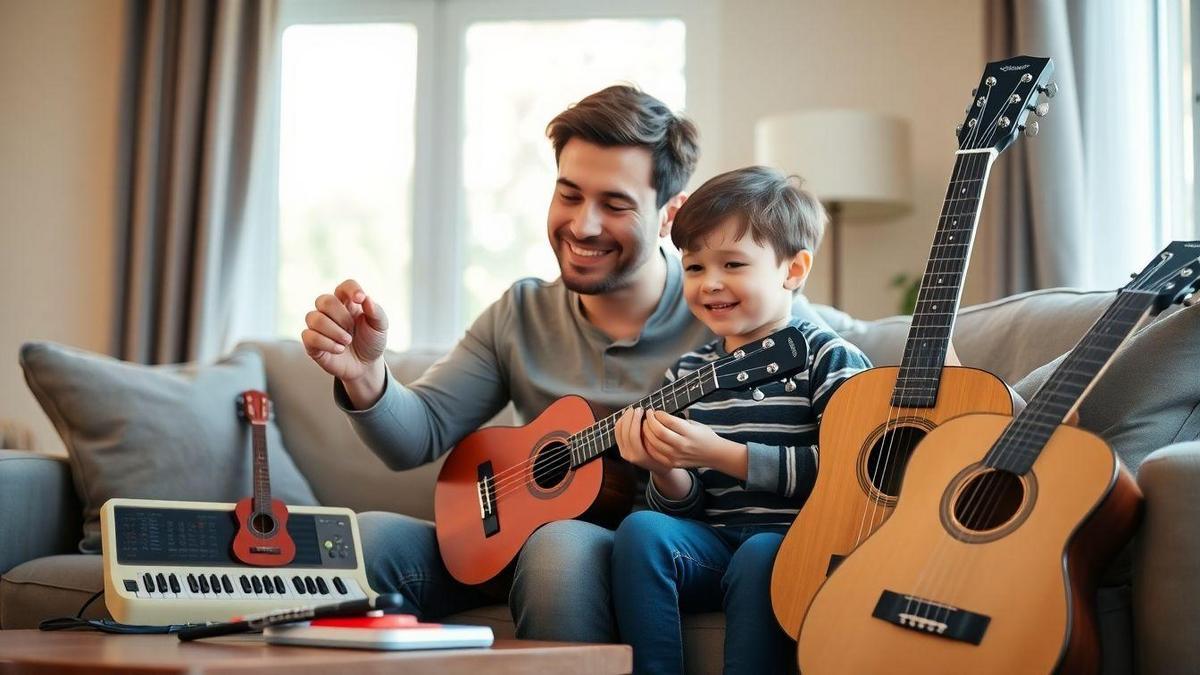
How I find easy instruments for adult beginners
Adults want fast wins, comfort, and fun. I test each for a week and choose instruments that match time availability.
| Instrument | Ease | Cost | Time to play songs |
|---|---|---|---|
| Ukulele | Very easy | $30–$100 | 2–6 weeks |
| Keyboard | Easy | $80–$200 | 3–8 weeks |
| Acoustic guitar | Moderate | $100–$300 | 4–12 weeks |
| Harmonica | Easy | $10–$50 | 1–4 weeks |
| Cajon | Easy | $60–$200 | 2–6 weeks |
Match choice to goals: sing along → ukulele/guitar; write melodies → keyboard; busk/jam → harmonica; rhythm → cajon.
Simple 12‑week plan for adult beginners
| Weeks | Focus | Measurable goal |
|---|---|---|
| 1–2 | Basics & comfort | Hold instrument and play 2 simple chords/patterns for 5 minutes |
| 3–4 | Repeatable songs | Play one full simple song at slow tempo |
| 5–8 | Build variety | Learn 3 songs & change chords smoothly |
| 9–12 | Play with others | Play with a backing track or record a short clip |
Daily routine: warm up 3–5 min, focus 10–20 min on one skill, play something fun 5–10 min. Follow a short course or routine for best results: how to create a simple practice routine and use focused, short sessions backed by the power of just twenty minutes daily.
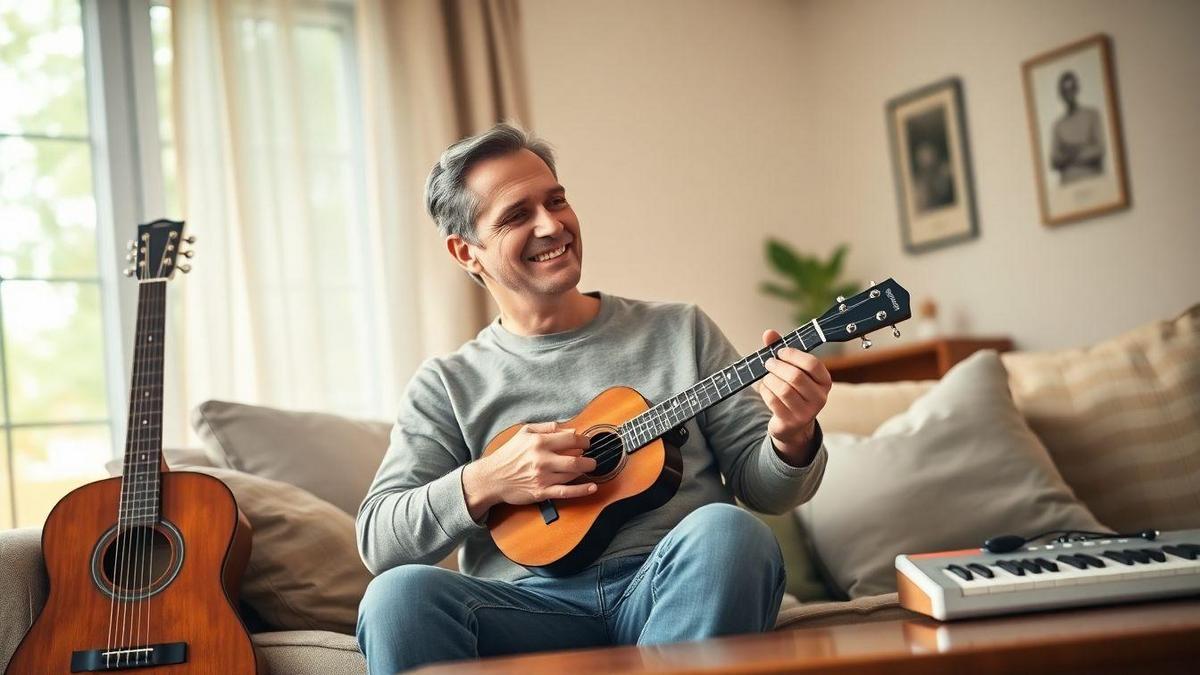
How I save money on accessories, repairs, and where to buy
Buy essentials only, test used gear in person, and prioritize must‑have accessories that protect sound and ease practice.
Essential low‑cost accessories
- Tuner (clip‑on for ukulele/guitar)
- Spare strings/reeds
- Picks and strap
- Soft gig bag
- Microfiber cleaning cloth and small tools
- Headphones for keyboards
Best beginner instruments under $100 (new & used)
I often look for these “5 affordable instruments perfect for beginners” choices when I’m shopping under $100:
| Instrument | Where to buy (new) | Where to buy (used) |
|---|---|---|
| Soprano ukulele | Big‑box stores, online | Local classifieds, Facebook Marketplace |
| Harmonica | Music shops, online | Thrift shops, used gear sites |
| Recorder (plastic) | School supply stores, online | Garage sales, secondhand markets |
| Kalimba | Online shops | Etsy, local buy/sell |
| Tin whistle | Folk shops, online | Flea markets, community groups |
Used purchases: play a few notes, check for buzzing, test keys or frets, and confirm return options when buying online.
For an extended shopping checklist and decisions to avoid buyer’s remorse, review how to choose your first instrument without regrets.
Smart shopping checklist
- Set a budget and stick to it.
- Inspect frets, bridge, keys, and holes.
- Play low and high notes to check for buzz or dead spots.
- Ask for a short trial/return window.
- Factor shipping into total cost.
- Buy essential extras only.
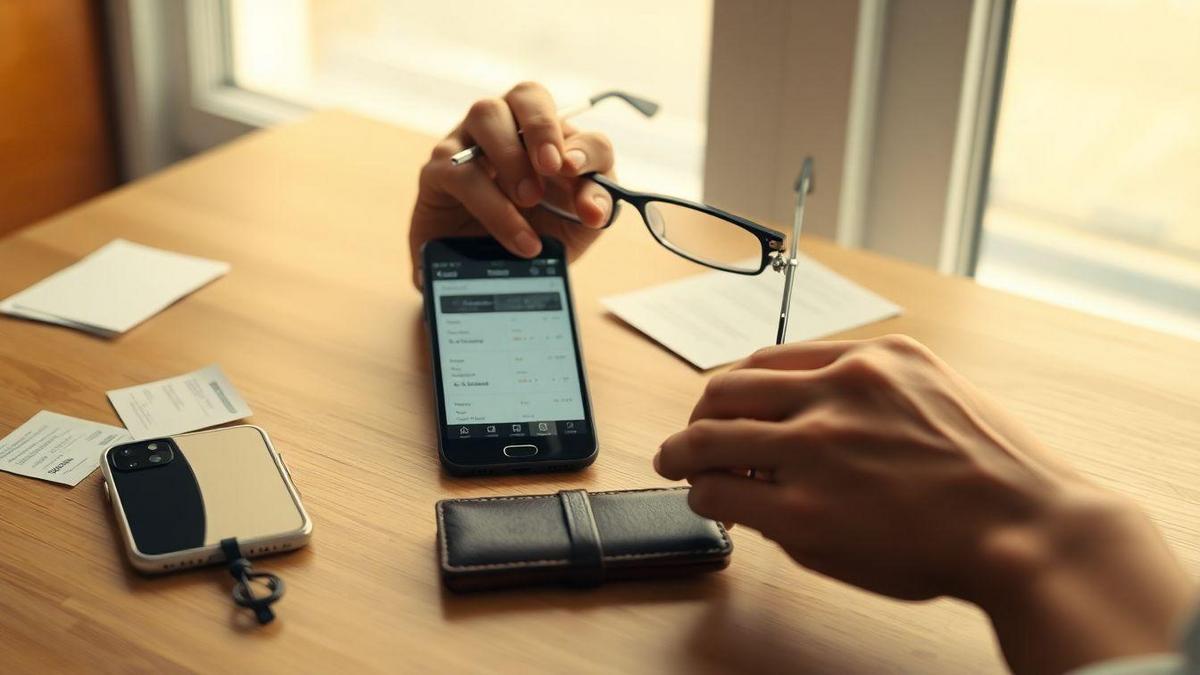
Conclusion
Pick an instrument that gives you fast wins, fits your budget, and feels comfortable. The five I recommend — ukulele, acoustic guitar, keyboard, recorder, and harmonica — balance cost, ease, and learning speed to keep practice fun and steady. Whether you want instant satisfaction (ukulele, recorder, harmonica) or broader long‑term options (guitar, keyboard), follow the smart shopping checklist, prioritize playability, and practice short daily sessions. Think of your first instrument as a stepping stone; small, consistent wins light the fire and keep you playing.
If nerves or self‑doubt are holding you back, these topics can help you move forward: overcoming the fear of starting music and talent vs practice: can anyone learn music.
For more practical tips, tests, and checklists, visit https://clickneutro.com.
Frequently asked questions
Q: Which 5 affordable instruments perfect for beginners should I try?
A: Ukulele, keyboard, acoustic guitar, recorder, and harmonica — all are cheap, portable, and fun. Start with the ukulele for quick wins. For guidance on choosing the right first instrument for your life and budget, see how to choose your first instrument without regrets.
Q: How do I pick the best one from the five?
A: Test sound, size, and price. Try in store or watch demos. Pick the one you enjoy most and fits your daily practice time. If you write songs, compare guitar vs keyboard options in guitar vs keyboard for songwriters.
Q: What gear and practice tips do I need to learn the five affordable instruments perfect for beginners?
A: A tuner, soft case, spare strings/reeds, and simple lessons. Practice 10–20 minutes daily and track progress with short, measurable goals. For routine templates and tips, read how to create a simple practice routine and basics on reading chords and notation in how to read chords and sheet music.
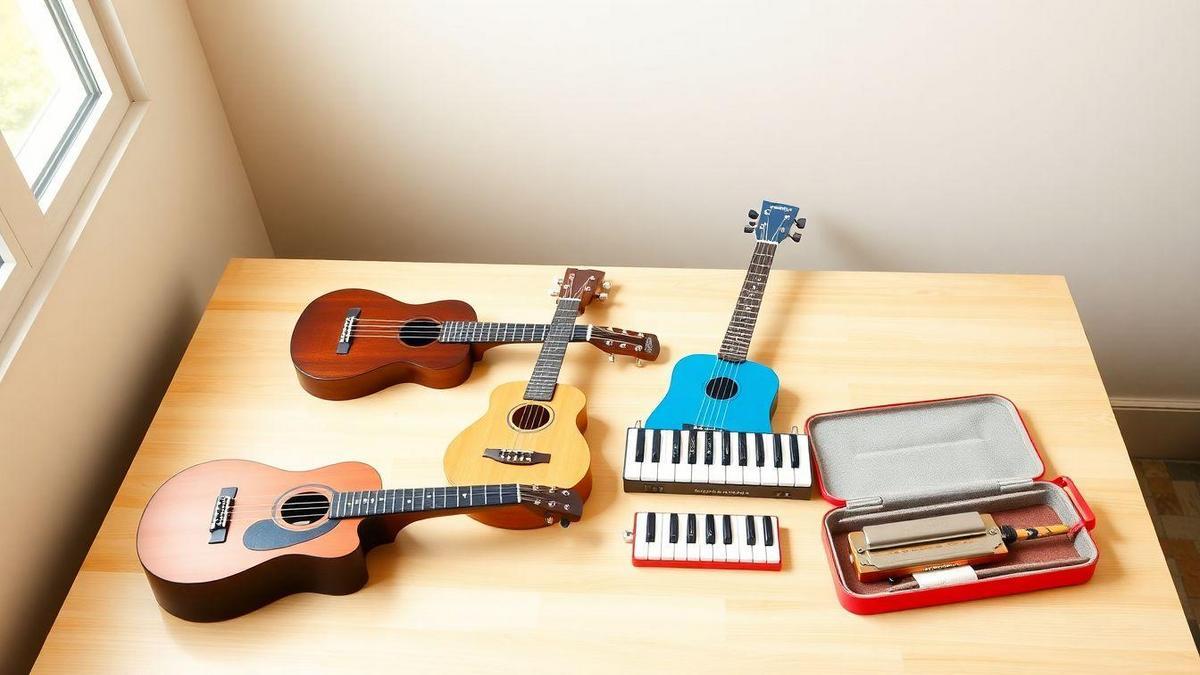
1 comentário em “Five affordable instruments perfect for beginners guide”